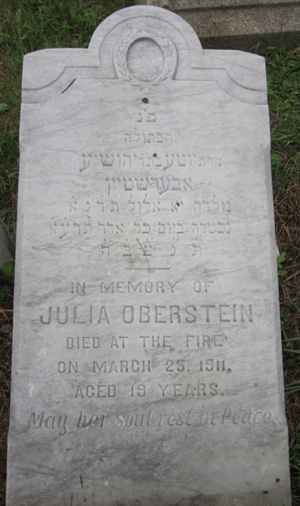On March 25, 1911, around 4:30pm, fire broke out on the 8th floor. Most on that floor and the executives on the 10th floor were able to escape, but workers on the 9th floor, who had not been alerted to the fire, found themselves trapped. Of the four 9th floor exits, the elevators made as many trips as they could but were commandeered by 8th floor workers and then stopped working altogether, one stairwell door was soon blocked by fire and smoke, the other stairwell door had been locked (although denied by the owners in their subsequent trial, it was common practice to lock factory workers in to prevent them from stealing) and the only fire escape collapsed under the weight of the escaping workers. Many died from being overcome by the smoke and flames quickly filling the building, some leapt down the elevator shafts, but 62 workers realized there was no other means of escape and jumped from the windows to the pavement 9 stories below. Or worse, they were pushed toward the open windows by the panicked crowd and had no choice. The fire department responded quickly, but their hoses' spray could not reach the top floors and ladders of the time were unable to reach above the 6th floor. By the time the fire was extinguished, 141 people had lost their lives. In the next few days, 5 more would die from their injuries.
The public outrage following the tragedy and subsequent acquittal of the company's owners paved the way for a flood of legislation to improve factory safety and hastened the growth and clout of the International Ladies' Garment Workers' Union. A bystander who witnessed the workers jumping from the windows was inspired to a life of public service fighting for the rights of factory workers; Frances Perkins went on to become the first woman appointed to a Presidential Cabinet position as Franklin Roosevelt's Secretary of Labor. The Triangle Shirtwaist Fire was the most deadly workplace disaster in New York City until the attack on the World Trade Center in 2001.∼Julia perished in the Triangle Shirtwaist Factory Fire in 1911 in NYC from a fractured skull. She either jumped out of the building or was pushed by a hysterical crowd trying to escape. She is the daughter of Yehoshua Oberstein and Tema, who are both buried in Warsaw. Julia immigrated to NY in 1907 to her sister, whose husband Isaac Kaplan is named on Julia's manifest. I am searching for these Kaplans. I do not know the sister's first name but her maiden name would be Oberstein.
On March 25, 1911, around 4:30pm, fire broke out on the 8th floor. Most on that floor and the executives on the 10th floor were able to escape, but workers on the 9th floor, who had not been alerted to the fire, found themselves trapped. Of the four 9th floor exits, the elevators made as many trips as they could but were commandeered by 8th floor workers and then stopped working altogether, one stairwell door was soon blocked by fire and smoke, the other stairwell door had been locked (although denied by the owners in their subsequent trial, it was common practice to lock factory workers in to prevent them from stealing) and the only fire escape collapsed under the weight of the escaping workers. Many died from being overcome by the smoke and flames quickly filling the building, some leapt down the elevator shafts, but 62 workers realized there was no other means of escape and jumped from the windows to the pavement 9 stories below. Or worse, they were pushed toward the open windows by the panicked crowd and had no choice. The fire department responded quickly, but their hoses' spray could not reach the top floors and ladders of the time were unable to reach above the 6th floor. By the time the fire was extinguished, 141 people had lost their lives. In the next few days, 5 more would die from their injuries.
The public outrage following the tragedy and subsequent acquittal of the company's owners paved the way for a flood of legislation to improve factory safety and hastened the growth and clout of the International Ladies' Garment Workers' Union. A bystander who witnessed the workers jumping from the windows was inspired to a life of public service fighting for the rights of factory workers; Frances Perkins went on to become the first woman appointed to a Presidential Cabinet position as Franklin Roosevelt's Secretary of Labor. The Triangle Shirtwaist Fire was the most deadly workplace disaster in New York City until the attack on the World Trade Center in 2001.∼Julia perished in the Triangle Shirtwaist Factory Fire in 1911 in NYC from a fractured skull. She either jumped out of the building or was pushed by a hysterical crowd trying to escape. She is the daughter of Yehoshua Oberstein and Tema, who are both buried in Warsaw. Julia immigrated to NY in 1907 to her sister, whose husband Isaac Kaplan is named on Julia's manifest. I am searching for these Kaplans. I do not know the sister's first name but her maiden name would be Oberstein.
Gravesite Details
19 years old. Victim of the Triangle Shirtwaist Factory fire.
Sponsored by Ancestry
Advertisement
Explore more
Sponsored by Ancestry
Advertisement










